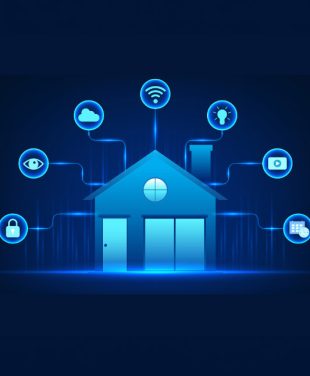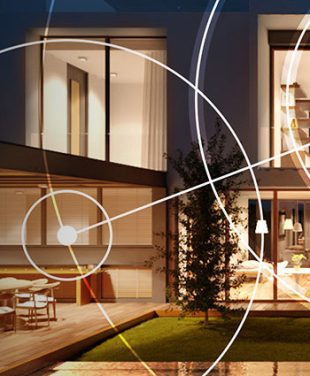The Impact of Multiple Devices in Your WiFi Network
When multiple devices are connected to the same WiFi network, they all share the available bandwidth. This can lead to slower speeds and decreased reliability, as each device requires bandwidth to send and receive data. Older WiFi 5 and WiFi 6 routers may struggle to meet the needs of today’s busy WiFi networks. The future-proofed solution is WiFi 7, the latest WiFi standard offering faster speeds and more bandwidth to combat buffering, latency, and frustratingly slow WiFi connections.
Q: What is WiFi Bandwith?
A: WiFi bandwidth is like the number of lanes on a freeway. The more lanes (bandwidth) you have, the more data (cars) can travel at the same time. More devices sharing the same bandwidth can slow things down, just like traffic on a busy freeway.
Try our WiFi Device Calculator to estimate how many devices are on your home network.
Understanding WiFi Technologies
WiFi technologies continue to evolve and improve. WiFi 7 can deliver wireless internet to a large number of client devices at speeds only achieved by the fastest LAN Ethernet cable and fiber router/device connections. But how did we get here?
(WiFi 4) IEEE 802.11n – 2009 – This major WiFi improvement upon previous standards includes the addition of multiple-input multiple-output antennas. 802.11n operates on both the 2.4 GHz and 5GHz bands and has data rate capability up to 600 Mbps.
(WiFi 5) IEEE 802.11ac – 2013 – Upgrades for AC compared to 802.11n include wider 5GHz band channels (80 or 160 MHz versus 40 MHz), up to 8 spatial streams, higher-order modulation (up to 256 QAM), and the addition of Multi-User MIMO (MU-MIMO).
(WiFi 6/6E) IEEE 802.11ax – 2020 – The progression to AX WiFi introduced the 6 GHz band alongside the 2.4 GHz and 5 GHz bands. WiFi 6E offers reduced interference and the higher capacity required to support emerging applications.
(WiFi 7) IEEE 802.11be – 2023 – WiFi 7 or WiFI BE provides seamless wireless connectivity for home networks, guest networks, and smart home IoT networks. This latest standard delivers blazing-fast theoretical multi-gigabit speeds as high as 42 Gbps, operating in the 2.4 GHz, 5 GHz, and 6 GHz frequency bands.
Meet WiFi 7: The Future of Connectivity
There is a growing reliance on wireless connectivity for various aspects of daily life at home, at work, and while on the road. WiFi 7, the seventh generation of WiFi, brings major improvements over WiFi 6 and 6E. WiFi 7 technologies include advanced features to reduce latency, increase capacity, boost stability, and improve network efficiency.
Key WiFi 7 features include:
- Faster real-world speeds: Up to 30Gbps, triple the speed of WiFi 6.
- Lower latency: Ideal for HD gaming and other real-time applications.
- Multi-Link Operation (MLO): Simultaneous multi-band connections for stability.
- 320 MHz Channels: Wider channels for more data throughput.
- 4K-QAM Modulation: Enhanced data encoding for efficiency.
NETGEAR Orbi and Nighthawk WiFi 7 routers offer almost unlimited potential for smart homes in the US. WiFi 7 can support multiple high-bandwidth devices simultaneously for 8K streaming, cloud gaming, AR/VR, and more exciting emerging applications. The additional bandwidth also makes WiFi 7 a great choice for connecting to the internet in dense WiFi environments where many networks and a large number of devices compete for stable and fast internet connections.
Multi-Band Routers: Dual-Band, Tri-Band, and Quad-Band Explained
Each new WiFi router generation offers significant advantages over the earlier generation.
Dual-Band WiFi Routers – Before WiFi 4, WiFi signals traveled on a single 2.4 GHz band. Wireless devices using this standard experience interference from other devices in the 2.4 GHz band. WiFi 5 and WiFi 6 dual-band routers include the 5 GHz band for greater network efficiency.
Tri-Band WiFi Routers – WiFi 5 & 6 Tri-band routers generally include an additional 5GHz band. This extra band acts as an exclusive highway for high-bandwidth activities. Tri-band routers can prevent network congestion in data-intensive environments. WiFi 6E and WiFi 7 tri-band routers use all 3 WiFi frequencies – 2.4GHz 5GHz and 6GHz.
Quad-Band WiFi Routers – The quad-band WiFi 7 technology (featured in the Orbi 970 Mesh System) includes one 2.4GHz band, two 5GHz bands, and one 6GHz band. Available bandwidth is maximized, making WiFi 7 ideal for smart homes with 15+ devices. The most powerful NETGEAR Nighthawk WiFi 7 routers and Orbi mesh network systems can handle up to 200 devices simultaneously. Future-proofed WiFi 7 includes enhanced capabilities to support upcoming technologies.
How to Determine If You Need an Upgrade
As the need for wireless router speed and reliability increases, your older home router may struggle to handle your internet connection requirements.
Signs you need a new router include:
- Your router can’t handle all the WiFi devices in your home network.
- Your router can’t deliver the internet speeds required for data-intensive applications.
- Your router doesn’t provide adequate sq. ft. coverage for your wireless network.
- You’re not getting the WiFi speeds you pay for from your internet service provider (ISP).
- Your router no longer receives firmware updates.
- You experience frequent disconnects that require your router to be rebooted.
- Your router is becoming erratic or overheated.
- Your router is close to five years old.
Try our WiFi Device Calculator to see how many WiFi devices you have.
The NETGEAR WiFi 7 Solution
NETGEAR has been pioneering WiFi technologies since the introduction of WiFi on a commercial scale in the late 1990s. The NETGEAR commitment to creating the best WiFi routers continues, including peerless WiFi 7 Nighthawk routers and Orbi whole-home mesh systems. For a WiFi upgrade like never before that can handle all the wireless connections in your present network, with unlimited potential for future expansion, you can trust NETGEAR.




